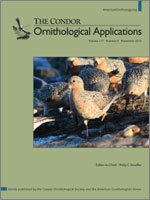Avian Urban Ecology: Behavioural and Physiological Adaptations edited by Diego Gil and Henrik Brumm. 2014. Oxford University Press. Oxford, United Kingdom. xv + 217 pp., 53 figures, 11 tables. ISBN 978-0-19-966157-2 (hardcover), $125. 978-0-19-966158-9 (paperback), $62.95
Many of ornithology's greatest contributions have originated in urban ecosystems. Rock Pigeons (Columba livia) helped Darwin illustrate the creative power of selection. Urban Swifts (Apus apus) informed Lack's thinking about clutch size. The restoration of Peregrine Falcons (Falco peregrinus) was a metropolitan affair. More holistic study of urban ecosystems, which flourished in occupied Berlin, Germany, from the 1950s to the 1980s, has resurged in the last two decades. In the last five years, for example, seven edited volumes concerning urban ecology have appeared (McDonnell et al. 2009, Gaston 2010, Douglas et al. 2011, Endlicher et al. 2011, Richter and Weiland 2011, Lepczyk and Warren 2012, Niemelä et al. 2012). Avian Urban Ecology is the latest installment in this growing field.
Avian Urban Ecology is in part a product of a 2010 symposium held at the European Conference on Behavioural Biology. In contrast to much of the prior work on bird ecology and evolution in urban ecosystems, this short book focuses on “the ways in which birds actually survive in our urban jungles.” The book's first twelve chapters synthesize the characteristics and influences of urban habitats (3 chapters), the behavioral and physiological adaptations enabling urban life (6 chapters), and the evolutionary mechanisms that adapt birds to the city (3 chapters). The remaining four chapters are more narrowly focused case studies. Because of its genesis, the chapters are decidedly reflective of European studies—all authors are from Europe, North America, or Australia—and mostly concerned with works published before 2011.
The urban ecologist will find some gems in this compilation. The three chapters concerned with evolution are excellent. Two of these synthesize phenotypic responses to urbanization from behavioral, population genetic, and landscape perspectives. The third reviews in depth the author's work on House Finch (Carpodacus mexicanus) beak evolution. I was disappointed that cultural evolution was not included in this eye-opening look at genetics and adaptation in urban systems. Chapters on the importance of night lighting, antipredator behavior, reproductive phenology, and disease transmission in urban areas also plough significant new ground. Syntheses of bird feeding, urban living, and predictions of urban success are fresh, but tell the reader little that was not already well known. Four chapters—three more than necessary for my taste—take up the topic of urban noise.
The student of urban ecology will find a long list of potential research topics suggested by each chapter. Some that jumped out to me include: Are male birds that nest under streetlights most successful at siring extra-pair offspring? How does urban bird feeding affect avian survival, reproduction, and the emergence of new diseases? What makes some birds more flighty than others? Are antioxidants limited in urban birds? How does the adaptive stress response temper successful response to urban noise? Does noise actually reduce fitness? What mechanisms generate phenotypic adjustments to urban life?
The conservation biologist will glean important strategies from this volume. For example, the hazards of at-sea oil rigs can be lessened with green lights; keeping urban green spaces dark and quiet may increase their appeal to rare urban species; nest boxes and bird feeders can be effective at enhancing some adaptable species' populations; maintaining normal disturbance cycles in urban areas may be necessary for some early successional species; gene flow, even in highly mobile birds, should be monitored as it is constrained by the most urban portions of the city; interdisciplinary teams will be needed to understand disease dynamics; and to fully understand how climate change will affect urban birds one must untangle the interactive effects of photoperiod, food, and temperature on aspects of migration and breeding.
An admirable feature of many works in this volume is the emphasis on causal understanding and the featuring of experimental studies. Because other volumes on urban ecology tend to focus on population and community ecology, such investigations are more rare. Unfortunately, long-term studies and studies that causally link landscape change to avian responses remain missing from this (and most other) recent publications.
Some readers will be dismayed by the independent nature of the contributions. Each chapter stands alone as an important journal article might, but this autonomy is also a bit distracting as the volume gains little synergy from the collected works. There is no grand synthesis of findings across chapters, little integration between chapters that cover similar material, and no consistency in chapter organization to help the reader synthesize.
Whether we like it or not, most of us are now “urban ornithologists.” Therefore, I recommend that we all become familiar with the approaches, findings, and implications of Avian Urban Ecology. Graduate students and professionals seeking to study urban ecosystems should read this book, consultants and researchers working in not-for-profit conservation organizations should buy it, and university libraries need to find a place on their shelves for this volume.






